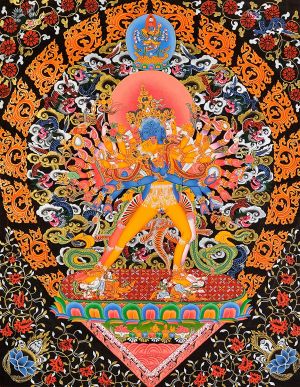Kālachakra Practice (Edward Henning Collection)
There is very little discussion of actual meditation practice on this site [kalacakra.org], and certainly no explanation how such practices should be performed. Similarly, there are no practice texts (sādhanas, pūjas, and so forth) available here for download, as availability of such materials is not only pointless without guidance and instruction from a qualified teacher, it would potentially be harmful.
Such guidance simply cannot be provided by a website, even with some kind of registration process, and anybody interested in practising Kālacakra, or any other Vajrayāna (rdo rje'i theg pa) practice, should first seek out a qualified teacher, if they are not already in touch with one. That teacher can then provide directly or indirectly the necessary practice materials, and sites such as this can hopefully provide useful or interesting support and reference information.
This site is therefore intended to provide background and otherwise hopefully interesting information, for the benefit of people who are actually practising Kālacakra or who have a general interest in Kālacakra. An internet site is a wholly inappropriate forum for the discussion of the details of meditation practices.
Kālacakra has a somewhat special position within Vajrayāna practices, but the general methods of such practices are followed with Kālacakra. First, as stated above, it is important that these practices are performed only under the guidance of a qualified teacher (lama).
There are several reasons for this, perhaps the most important being that one should be guided by somebody who themself already has considerable experience in the type of practices being performed. It is surprisingly easy to get these things wrong, to practise in a way that either has no benefit at all, or is even confusing or perhaps harmful in some way.
There is also a generally accepted order in which practices are learned and performed. Major Vajrayāna yidam practices such as Kālacakra require very careful, and very thorough preparation, which may take several years, before the main practice is commenced. This is important for the practices to be properly effective. This degree of preparation may well vary from individual to individual, but such variations can only be judged by a qualified teacher.
All the major traditions have particular sets of preliminary practices (sngon 'gro) which are performed before the yidam practice. It does not really matter which tradition of these is performed, as their content is very similar.
H.H. Dalai Lama was asked some years ago if he would consider writing a Ri-me set of preliminary practices (meaning not affiliated with any particular tradition). His reply was that there was no shortage of preliminary practices, but the problem was that there were not enough people performing such preliminaries.
The basic structure of these preliminaries consists of several steps. Often the first are a set of four meditations that are sometimes called the ordinary preliminaries, or the four meditations to change attitudes. These are the contemplation of:
1) the difficulty of obtaining the freedoms and conditions, in other words the precious human existence and the valuable opportunity this presents for practice;
2) the recollection of death and the transitory nature of existence and all phenomena;
3) examining the ways in which actions mature into results, often called in the west the "law of karma"; and, 4) the viciousness of cyclic existence, the suffering that is experienced by beings not on the path to enlightenment. These meditations are intended to provide a strong and proper motivation for practice, a stable sense of renunciation; the understanding that there is nothing to be gained from cyclic existence and the determination to act to achieve liberation from that existence.
